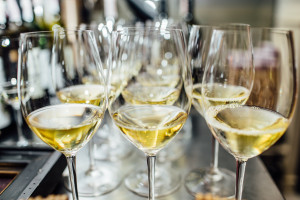Enquiring wine students most likely know that Cava—Spain’s well-known and widely-popular traditional method sparkling wines—can be produced in various parts of Spain. While the majority of Cava DO is produced in Catalonia, in reality the geographical indication for Cava spreads across eight regions of Spain, including La Rioja (and overlapping portions of the Rioja DOCa). While somewhat of a rarity, there are about five wineries that produce Cava within the confines of the Rioja DOCa. They have, in the past, been bottled under the Cava DO (and may continue to be).
However….as of 2019, consumers will be able to drink sparkling wines produced under the Rioja DOCa. That’s right…sparkling Rioja—known as Vino Espumoso de Calidad de Rioja DOCa—is now a thing. This is a big change in the rules and regulations concerning the wines of the Rioja DOCa; part of a wave of modernization and re-organization of the Rioja DOCa that has been brewing for the last few years. You may recall that last year (in 2017), single-village designations and single-vineyard designations were approved for wines produced under the Rioja DOCa.
Espumoso de Calidad de Rioja DOCa may be produced in white (blanco) and rosé (rosado/rosat) styles, and must be produced using the traditional method of sparkling wine production with the second fermentation occurring in the bottle. Any of the grape varieties approved for use in the still wines of the Rioja DOCa may be used in the production of these sparkling wines. The approved grapes include the following white varieties: Viura, Chardonnay, Sauvignon Blanc, Verdejo, Malvasía, Garnacha Blanca, Tempranillo Blanca, Maturana Blanca, and Turruntés—and these red varieties: Tempranillo, Garnacha Tinta, Mazuelo, Graciano, and Maturana Tinta.
Further rules and regulations concerning Vino Espumoso de Calidad de Rioja DOCa include the following:
- The finished wines must contain between 11% and 13% alcohol by volume.
- All wines using the Espumoso de Calidad de Rioja DOCa must be sur lie aged (in the bottle, following the second fermentation) for a minimum of 15 months.
- Those wines labeled as “reserva” must be sur lie aged in the bottle for a minimum of 24 months
- Those wines labeled as “gran reserva” must be sur lie aged in the bottle for a minimum of 36 months
- These wines may only have a limited amount of sugar, and may only be produced in the following styles: Brut (less than 12 g/L of residual sugar), Extra Brut (less than 6 g/L of residual sugar), and Brut Nature (less than 3 g/L of sugar, no dosage allowed).
- Sparkling rosés must contain a minimum of 25% red grapes
- The term “Vino Espumoso Gran Añada” may be used for vintage wines with the vintage date stated on the label.
I am looking forward to trying a sparkling wine from the Rioja DOCa and will be on the lookout for one beginning in 2019. Let us know if you find one!
References/for more information:
- http://especiales.lomejordelvinoderioja.com/2017/espumosos-rioja.php
- https://www.thedrinksbusiness.com/2018/04/everything-you-need-to-know-about-riojas-new-rules/
- https://www.riojawine.com/es-es/consejo-regulador-doca-rioja/
- Pliego de Condiciones Rioja DOCa 2018


Excellent and concise wine world update, much appreciated when so many of the sources are likely in Spanish! Thank you!